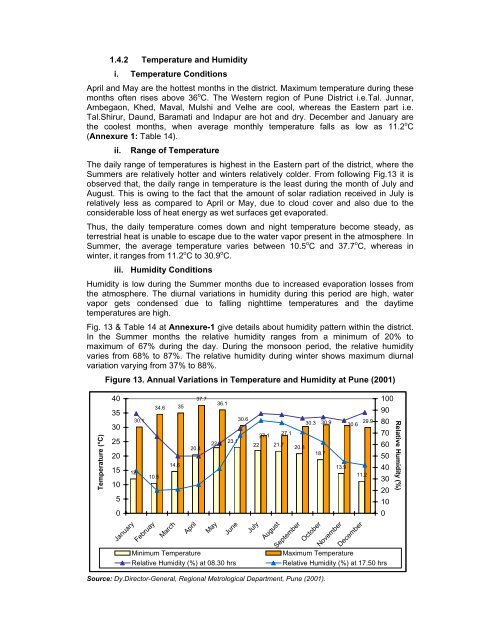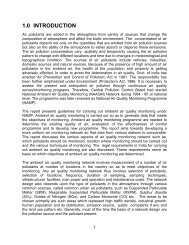Chapter 1 GENERAL FEATURES OF PUNE DISTRICT
Chapter 1 GENERAL FEATURES OF PUNE DISTRICT
Chapter 1 GENERAL FEATURES OF PUNE DISTRICT
Create successful ePaper yourself
Turn your PDF publications into a flip-book with our unique Google optimized e-Paper software.
1.4.2 Temperature and Humidity<br />
i. Temperature Conditions<br />
April and May are the hottest months in the district. Maximum temperature during these<br />
months often rises above 36 o C. The Western region of Pune District i.e.Tal. Junnar,<br />
Ambegaon, Khed, Maval, Mulshi and Velhe are cool, whereas the Eastern part i.e.<br />
Tal.Shirur, Daund, Baramati and Indapur are hot and dry. December and January are<br />
the coolest months, when average monthly temperature falls as low as 11.2 o C<br />
(Annexure 1: Table 14).<br />
ii. Range of Temperature<br />
The daily range of temperatures is highest in the Eastern part of the district, where the<br />
Summers are relatively hotter and winters relatively colder. From following Fig.13 it is<br />
observed that, the daily range in temperature is the least during the month of July and<br />
August. This is owing to the fact that the amount of solar radiation received in July is<br />
relatively less as compared to April or May, due to cloud cover and also due to the<br />
considerable loss of heat energy as wet surfaces get evaporated.<br />
Thus, the daily temperature comes down and night temperature become steady, as<br />
terrestrial heat is unable to escape due to the water vapor present in the atmosphere. In<br />
Summer, the average temperature varies between 10.5 o C and 37.7 o C, whereas in<br />
winter, it ranges from 11.2 o C to 30.9 o C.<br />
iii. Humidity Conditions<br />
Humidity is low during the Summer months due to increased evaporation losses from<br />
the atmosphere. The diurnal variations in humidity during this period are high, water<br />
vapor gets condensed due to falling nighttime temperatures and the daytime<br />
temperatures are high.<br />
Fig. 13 & Table 14 at Annexure-1 give details about humidity pattern within the district.<br />
In the Summer months the relative humidity ranges from a minimum of 20% to<br />
maximum of 67% during the day. During the monsoon period, the relative humidity<br />
varies from 68% to 87%. The relative humidity during winter shows maximum diurnal<br />
variation varying from 37% to 88%.<br />
Figure 13. Annual Variations in Temperature and Humidity at Pune (2001)<br />
Temperature (°C)<br />
40<br />
35<br />
30<br />
25<br />
20<br />
15<br />
10<br />
5<br />
0<br />
12<br />
January<br />
30.1<br />
10.5<br />
Februay<br />
34.6<br />
14.6<br />
March<br />
35<br />
20.4<br />
April<br />
37.7<br />
22.9<br />
36.1<br />
23.1<br />
May<br />
June<br />
30.6<br />
30.3 30.9 29.9<br />
30.6<br />
22<br />
July<br />
27.1<br />
21.7<br />
August<br />
27.1<br />
20.8<br />
September<br />
18.7<br />
October<br />
13.9<br />
November<br />
11.2<br />
December<br />
Minimum Temperature Maximum Temperature<br />
Relative Humidity (%) at 08.30 hrs Relative Humidity (%) at 17.50 hrs<br />
Source: Dy.Director-General, Regional Metrological Department, Pune (2001).<br />
100<br />
90<br />
80<br />
70<br />
60<br />
50<br />
40<br />
30<br />
20<br />
10<br />
0<br />
Relative Humidity (%)

















